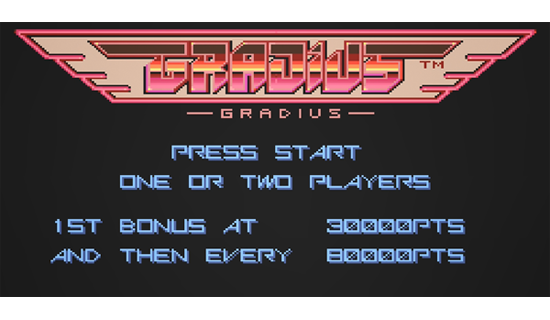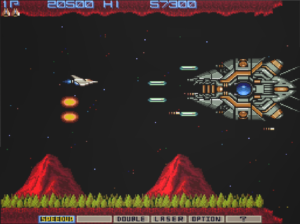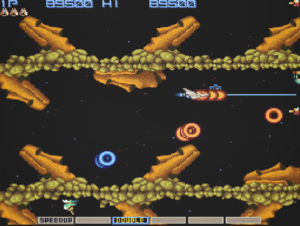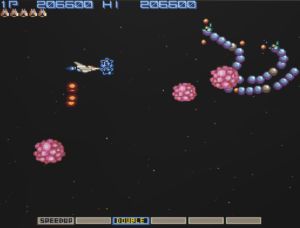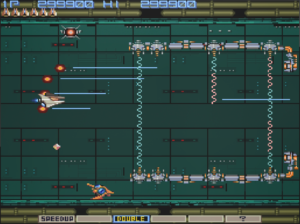Gradius (originally titled “Choujikuu Fighter Gradius”) wasn’t the first shoot ’em up to grace arcades with its presence, in fact many big names came before it. Space Invaders, Xevious, Galaxian, Ozma Wars, and even western titles like Asteroids and Defender all came first. So why was Gradius significant? Not only did it introduce several “characters” that would reoccur throughout the Konami universe (The very ship that you control called the Vic Viper, Moai heads, etc), but because it fleshed out the details of exactly what the average horizontal shoot ’em up would become: A game about strict power-up management, and pattern observation/memorization, and reaction. This may sound negative, but shoot ’em up fans (myself included) have long since embraced what the genre is, and they really have Gradius to thank for making it that way.
Let’s start with pattern memorization. It’s possible get through Gradius without taking the time to remember enemy patterns, assuming that you can react to them quickly enough. Though things can get hectic (to the point where slowdown even occurs), the screen won’t fill up with so many bullets that this could be considered an early “bullet hell” shooter. Pattern memorization (or at least familiarity with what’s going to happen at any point in each stage) still remains one of the best paths to a quick and easy (easier?) run through this game. Previous shoot ’em ups wouldn’t place nearly this level of emphasis on patterns as a tool for progressing in the game.
An even more novel idea than introducing real enemy patterns is distinctive Gradius power-up system. It will be used in pretty much every Gradius sequel and spin-off from here on, and will be the series hallmark. You obtain a unit on your power-up bar by defeating specific enemies (or strings of enemies), and collecting one advances one spot to the right on the meter. You have several choices of power-ups, and all of them are important in the right situations: “Speed Up”, “Missile”, “Double”, “Laser”, “Option” and “?”. You can choose to power-up your ship via these choices in any order that you like, but choosing an order that turns you into a killing machine the quickest is absolutely necessary to surviving just about any level past the first. The most popular tactic is a couple of speed ups, missiles (which fire using a separate button from your main weapon), lasers, all four options, and “?” (a shield that sits in front of the Vic Viper to absorb several bullets). If you don’t do this, things start to feel exactly like the game’s slogan: “1985 uchuu ga, marugoto, yatte kuru” (“In 1985, all of space is coming for you”).
There are seven stages in Gradius, and while they aren’t all dripping with style, they show more of it than just about any shooter that’s come before it. Gone is the idea of the same level backgrounds (or slight variations of them) repeating over and over again, in favor of volcanoes and vaguely biological bubble things. And while many of the enemies are just standard looking space ships of various types, you do get something very different sometimes, such as the Moai heads straight from Easter Island. Unfortunately not much variety is extended to the bosses. After facing some sort of challenge (rocks coming up from a volcano, a ton of small ships appearing out of thin air at you, taking down a bunch of weird bio-organic masses with tentacles attached, etc.), the Big Core will immediately appear as the level’s boss. It’s always a very sample fight that uses the same pattern: break through the front of it and destroy its core, while moving up and down to dodge its blasts. There are only two other bosses in the game (counting the incredibly easy final boss) apart from the many instances of the Big Core. If you manage to complete the game, you’ll be treated to a very brief ending, and then you immediately enter the second loop of the game, which of course increases the difficulty.
But let’s not forget about the fantastic music of Gradius. This would also reoccur throughout the series, but I don’t think any of it would end up being quite as special or highly regarded as the music found in the first game. Every level starts out with the same theme as you go from the black background of space into the level proper, and then the music moves into the theme of the actual level, before eventually moving into the more frantic song that plays when you’re taking down the Big Core. The soundtrack is maybe one of the most celebrated elements of Gradius, with several remix albums having been released over the years. In fact chip-tune/hip-hop group Family Continue, featuring MCU (or MC 8bit) of Kick the Can Crew and solo fame as the MC, used the main theme from Gradius as their very first track: “MC8bit VS GRADIUS”
Because of its relative simplicity in its game systems, Gradius is still very playable today for those who are willing to put a little time into learning the game. Its major flaw is absolutely the hopeless situation you’re thrown into when you die basically anytime after the first level, and completely lose all of your power-ups. Depending on the level, it can be next to impossible to get them all back before being thrown into a situation that you just can’t handle powered down. And at that point, you might as well just start the game over from the beginning and hope you don’t make the mistake of dying once! The Gradius formula will certainly be improved over time to make it even more accessible, but it’s still great to look back and see the humble beginnings of what has since become a very treasured series to the shoot ’em up genre. These days though, most will probably not have much patience for making it all the way through without save states though.
Gradius has so many ports that it’s difficult to keep track of them all, and many of them were at least decent representations of the original: Famicom/NES, MSX, PC-8801, X1, Commodore 64, Amstrad CPC, ZX Spectrum, X68000, PC Engine (Japan only), along with various Windows and mobile phone ports over the years. It’s also appeared on several great collections: Gradius Deluxe Pack (PlayStation, Saturn, and Windows 95), Gradius Portable/Gradius Collection (PSP), and Konami Arcade Collection/Konami Classics Series: Arcade Hits (Nintendo DS). The most easily accessible and highly recommended version though is the Arcade Archives series version by Hamster, that can be found for download on PlayStation 4. It has a lot of options to adjust how easy or difficult the game is and how it looks, and even includes the North American and European versions that were released under the name “Nemesis”. Game designer and director for PlatinumGames, and noted Gradius enthusiast Hideki Kamiya has also stated that this is an arcade perfect version.
